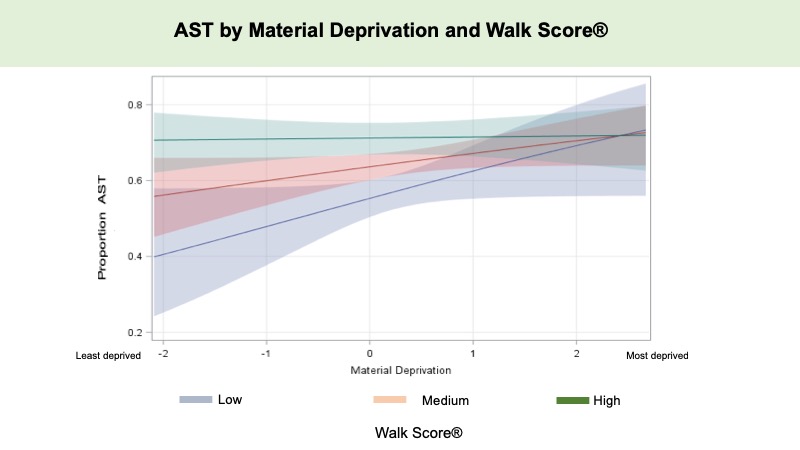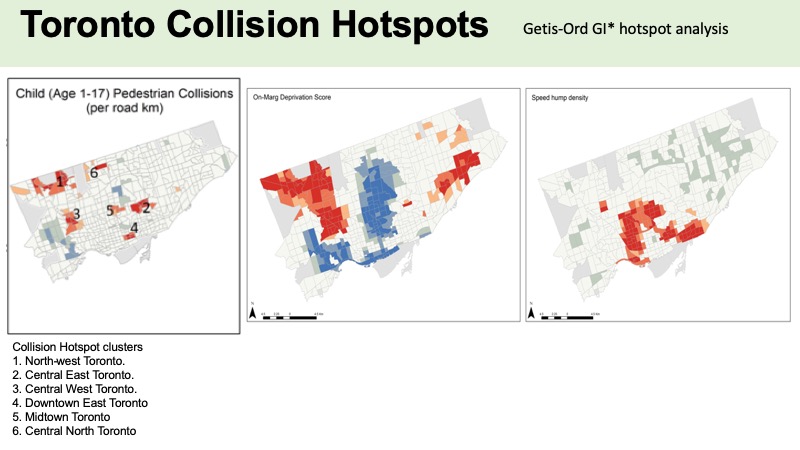The equity dimension of safer streets for kids: lessons for Toronto
Dr. Linda Rothman (opens in new window) (Assistant Professor, School of Occupational and Public Health, Ryerson University) recently led a team including multiple researchers--from Ryerson University, York University, the Hospital for Sick Children and University of Toronto, the Institut National de la Recherche Scientifique in Montreal and Parachute--to complete two cross-sectional studies related to children’s health as it relates to mobility. The first looks at active school transportation, and the extent to which social factors and/or built environment are related to walking, biking or scootering to school. The second study investigates the relationship between social indicators and child pedestrian-motor vehicle collisions (PMVCs). Together, the results outline a complex problem of inequity among neighbourhoods--and a challenge for cities hoping to encourage not just active transportation but zero road fatalities (external link) .
Social Factors and Active School Transportation
When children travel to school using active transportation (AT), it benefits their health, and the health of the environment. It has long been observed that social factors--particularly low household income and immigrant status--play a role in choosing AT as a means to get to school. However, exactly how social factors influence this decision, when considered against others, is not well understood.
In their first study, Dr. Rothman, graduate student Vijay Kunaratnam and post-doctoral fellow Naomi Schwartz and their team sought to discover the key to influencing more people to choose active school transportation by undertaking a cross-sectional study examining census-derived social factors and local built environment factors surrounding 105 public elementary schools in Toronto.
In essence, the results of this study indicate that high neighbourhood walkability, as measured by WalkScore®, is associated with active school transportation among all populations. However, in neighbourhoods with low walkability, AT is being used in journeys to and from school primarily in more deprived areas and areas with higher proportions of recent immigrants. The study found that where the walkability is high, there is no difference in AT between more and less deprived areas.

Social inequalities in child pedestrian collisions
The team’s second study focused on child pedestrian-motor vehicle collisions (PMVCs), a major public health issue considering that road injury is a leading cause of death among children and youth globally, and the third leading cause of death among children aged 1 to 19 in Canada. Previous studies have noted higher rates of risk of child PMVCs associated with low socioeconomic status. But how much do social factors weigh in child PMVCs when compared to the features of roads themselves?
To answer this question, Dr. Rothman, Dr. Schwartz and their team examined the 2028 police-reported child PMVCs in Toronto from 2010-2018, mapping them by census tract, and applying various modelling and analytical techniques to discover the relationship between area-level social dimensions and features of the built environment (including traffic interventions, roadway environments and land use features).
They identified six hotspot areas for child PMVCs in the North-west, Central East, Central West, Downtown East and Midtown areas of the city. Their results demonstrate that many Toronto neighbourhoods experiencing the greatest social challenges, and containing significant populations of new immigrants and visible minorities, are also at higher risk of child PMVCs. Many of these areas also do not have traffic calming features, which have been found to be effective in reducing collisions.

The lessons for Toronto
Selecting active transportation as a means to get to school is a healthy choice--one that should be encouraged in urban planning, design and policy. The study results suggest that modifying the built environment to improve walkability may equalize social disparities in active transportation.
However, the reality today is that active transportation is often the only choice for low-income families with fewer mobility options, which in certain neighbourhoods may put children at higher risk of injury.
“We know from past evidence that interventions related to speed reduction, such as speed humps are effective in reducing collisions. Yet, these features did not show up as significant protective factors in our results. This is likely because there is very little traffic calming around schools in marginalized areas in Toronto where it is needed. This is a problem that puts kids at risk,” said Dr. Rothman.
The solution is not to incentivize driving over the healthier option of active transportation, but rather to address equity issues along with road design in order to ensure all streets are safe for children, especially those in hotspot areas with the highest incidence of child PMVCs. Bottom line: increasing road safety features throughout the city will help to prevent child PMVCs and also encourage active school transportation across all groups.
Dr. Rothman’s latest research provides evidence of important social inequalities, and a need to target traffic safety interventions in specific socially marginalized areas to ensure progress on the City of Toronto’s Vision Zero Road Safety Plan (external link) .